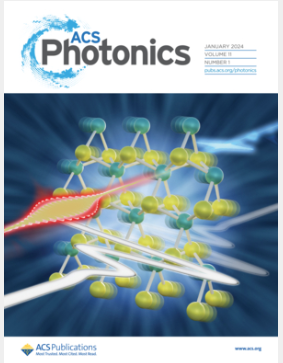Low-Loss Nanophotonic Devices with Chip-Level Uniformity and Integrated Color Centers in an SiC-On-Insulator
IF 6.5
1区 物理与天体物理
Q1 MATERIALS SCIENCE, MULTIDISCIPLINARY
引用次数: 0
Abstract
4H–SiC is a promising material platform for quantum photonic integrated circuits due to its wide bandgap, high refractive index, and variety of optically addressable defects, while being compatible with CMOS fabrication processes. However, it is currently not possible to fabricate chip-scale photonic integrated circuits with integrated color centers due to nonuniformity of SiC thickness arising from the SiC-on-insulator fabrication process. We apply the concept of dopant-selective photoelectrochemical etching to a SiC-on-insulator stack for a highly effective total thickness variation (TTV) reduction. We show a reduction of SiC TTV by a factor of 7 through selectively etching a high-TTV sacrificial n-type layer, to stop on an epitaxially defined intrinsic layer. Fabricated photonic devices on selectively etched SiCOI exhibit a high yield of optical elements while maintaining a record low propagation loss for 920 nm single-mode optical elements in SiC (2 dB/cm). Finally, we show etch process compatibility with color centers through the measurement of zero phonon line emission from ensemble divacancy defects into our fabricated waveguides. This work represents the first successful demonstration of a TTV reduction method in SiCOI that is compatible with color center emission, marking a significant advancement toward scalable 4H–SiC-on-insulator integrated photonics for quantum technologies.

具有片级均匀性和绝缘体上集成色心的低损耗纳米光子器件
4H-SiC具有宽带隙、高折射率和多种光学可寻址缺陷等优点,是一种很有前途的量子光子集成电路材料平台,同时与CMOS制造工艺兼容。然而,由于SiC-on-绝缘体制造过程中SiC厚度的不均匀性,目前还不可能制造出集成色心的芯片级光子集成电路。我们将掺杂剂选择性光电化学蚀刻的概念应用于绝缘体上的sic堆叠,以高效地减少总厚度变化(TTV)。我们展示了通过选择性蚀刻高TTV牺牲n型层将SiC TTV降低了7倍,以停止在外延定义的本征层上。在选择性蚀刻SiCOI上制备的光子器件显示出高的光学元件产率,同时在SiC中保持创纪录的920 nm单模光学元件的低传播损耗(2 dB/cm)。最后,我们通过测量从系综距离缺陷到我们制造的波导的零声子线发射来证明蚀刻工艺与色心的兼容性。这项工作代表了SiCOI中与色心发射兼容的TTV还原方法的首次成功演示,标志着量子技术在可扩展的绝缘体上4h - sic集成光子学方面取得了重大进展。
本文章由计算机程序翻译,如有差异,请以英文原文为准。
求助全文
约1分钟内获得全文
求助全文
来源期刊

ACS Photonics
NANOSCIENCE & NANOTECHNOLOGY-MATERIALS SCIENCE, MULTIDISCIPLINARY
CiteScore
11.90
自引率
5.70%
发文量
438
审稿时长
2.3 months
期刊介绍:
Published as soon as accepted and summarized in monthly issues, ACS Photonics will publish Research Articles, Letters, Perspectives, and Reviews, to encompass the full scope of published research in this field.
 求助内容:
求助内容: 应助结果提醒方式:
应助结果提醒方式:


